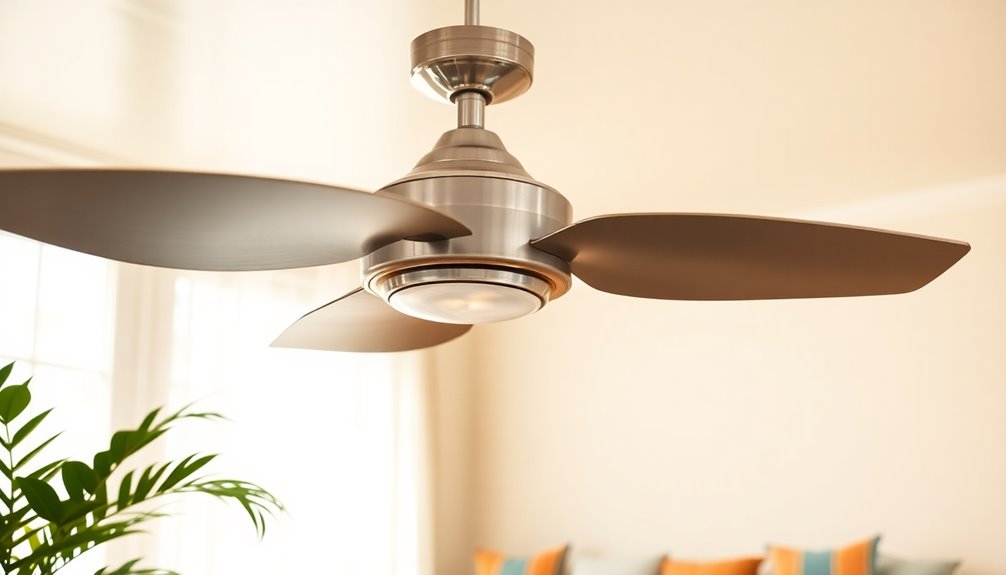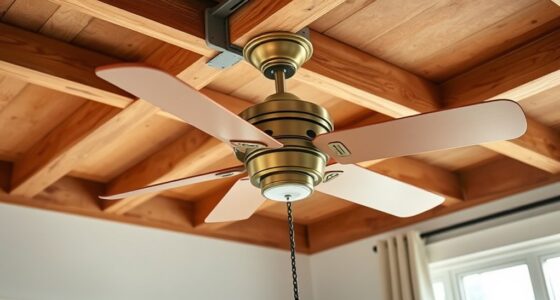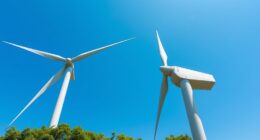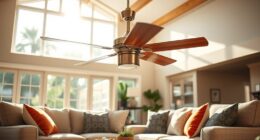To keep your space cool in summer, set your ceiling fan to rotate counterclockwise. This direction creates a cooling downdraft, making the air feel about 4 degrees cooler. It enhances air circulation and reduces your reliance on air conditioning, which can lower your energy costs considerably. Remember to switch the fan's direction during Daylight Savings Time; it's an easy way to maintain comfort year-round. If you're not sure how to change the direction, or want tips on optimizing fan use in different rooms, there's plenty more helpful information to discover.
Key Takeaways
- Ceiling fans should rotate counterclockwise in summer to create a cooling downdraft and enhance comfort.
- This counterclockwise rotation allows for thermostat settings to increase by about 4 degrees without sacrificing comfort.
- Regularly adjusting the fan direction twice a year maximizes energy efficiency and comfort throughout the seasons.
- Most ceiling fans have a switch on the motor housing to change direction; smart fans can be adjusted via apps or voice commands.
- Proper ceiling fan operation can reduce cooling costs by up to 30%, making it an energy-efficient alternative to air conditioning.
Importance of Ceiling Fan Direction

Understanding the importance of ceiling fan direction can greatly enhance your home's comfort during the hot summer months.
When your ceiling fan rotates counterclockwise, it creates a cooling downdraft that improves air circulation throughout your space. This simple adjustment can make a significant difference in how comfortable you feel without cranking up the air conditioning.
By optimizing ceiling fan direction, you can reduce reliance on your AC unit, potentially lowering your energy costs by up to 30%. You can even raise your thermostat setting by about 4 degrees without sacrificing comfort, thanks to the effective airflow generated by a properly adjusted fan.
Moreover, a ceiling fan typically uses around 50 watts compared to the staggering 3,500 watts that air conditioning systems consume.
This means that operating your fan in the right direction not only enhances comfort but also helps save energy.
Recommended Summer Rotation

To beat the summer heat, you should set your ceiling fan to rotate counterclockwise.
This direction enhances the cooling effect, making you feel more comfortable while potentially saving on energy costs.
Counterclockwise Blade Direction
During the hot summer months, setting your ceiling fan to rotate counterclockwise is essential for creating a revitalizing downdraft. This counterclockwise motion pushes cool air down towards you, enhancing your comfort while reducing the need for air conditioning.
By adjusting your ceiling fan in this way, you can raise your thermostat setting by about 4 degrees and still feel comfortable, leading to significant energy savings.
Operating your ceiling fan in the counterclockwise direction uses only about 50 watts of energy compared to the 3,500 watts typically consumed by air conditioning units.
The increased airflow mimics the wind chill effect, cooling your skin without actually lowering the room temperature. This effect makes the environment feel more pleasant while keeping your energy bills in check.
Enhanced Cooling Effect
Feeling the heat of summer can be a challenge, but adjusting your ceiling fan to rotate counterclockwise can make a world of difference. This direction creates a cooling downdraft, enhancing airflow and comfort. When your ceiling fan spins counterclockwise, it generates a cool breeze that can make your space feel up to 4 degrees cooler.
Here's a quick overview of the benefits:
| Benefit | Description |
|---|---|
| Enhanced Air Movement | Increases airflow for a more comfortable space |
| Cooling Effect | Creates a wind chill effect, improving comfort |
| Proper Blade Angle | A minimum of 12 degrees guarantees maximum efficiency |
Additionally, utilizing a ceiling fan in conjunction with energy-efficient models can further optimize your home's temperature regulation and comfort.
Energy Cost Savings
Adjusting your ceiling fan to rotate counterclockwise in the summer can lead to significant energy cost savings. This ceiling fan direction creates a cooling downdraft, enhancing your comfort and producing a wind chill effect.
By operating your fan in counterclockwise motion, you can raise your thermostat setting by about 4 degrees without sacrificing comfort, resulting in notable energy savings on air conditioning costs.
A ceiling fan typically consumes around 50 watts of energy, while an air conditioning unit can use approximately 3,500 watts. This stark difference highlights the energy-efficient nature of fans compared to traditional cooling methods.
When you pair a ceiling fan with an ENERGY STAR-rated air conditioning unit, you can increase overall efficiency by about 8%, further lowering your energy bills.
Utilizing the correct fan speed and direction in summer can help reduce cooling costs by up to 30%. Regular maintenance of your air conditioning system can also enhance its efficiency, contributing to further energy savings.
So, don't underestimate the power of your ceiling fan. By ensuring it spins counterclockwise, you're not only improving your comfort but also taking a proactive step towards energy savings.
Make this simple adjustment, and enjoy a cooler home without breaking the bank!
Energy Savings With Ceiling Fans

When you run a ceiling fan counterclockwise in summer, you can create a cooling downdraft that not only enhances your comfort but also reduces your reliance on air conditioning. This simple adjustment can lead to significant energy savings for homeowners, allowing you to keep cool without cranking up your air conditioning costs. Additionally, utilizing energy-efficient systems can further enhance your savings and reduce overall energy demand.
Here's how the energy savings stack up:
| Feature | Impact |
|---|---|
| Ceiling Fan Power Consumption | ~50 watts |
| Air Conditioning Power Consumption | ~3,500 watts |
| Potential Thermostat Increase | Up to 4 degrees |
| Cooling Costs Savings | 20-30% |
| Efficiency Improvement with ENERGY STAR | Up to 8%
Changing Fan Direction

To change the ceiling fan direction for summer cooling, first confirm the fan is off and has completely stopped. This is essential for your safety and to prevent any accidents while adjusting the fan.
Most ceiling fans come with a fan switch located on the motor housing that allows you to change the direction to counterclockwise. This rotation creates a revitalizing downdraft, pushing cool air downwards, which is perfect for those hot summer days. Air purifiers can also enhance comfort by improving indoor air quality during the summer months. Additionally, using a ceiling fan in conjunction with an airless paint sprayer can help maintain a comfortable environment while painting indoors.
If you have a remote-controlled fan, simply press and hold the fan button on the remote to toggle the direction. A blinking light will indicate that you've successfully changed the direction.
For smart ceiling fans, you can easily adjust the ceiling fan direction through an app or compatible voice commands, making it convenient without the need for manual intervention.
Once you've made the adjustment, stand underneath the fan to check the rotation. Verify the blades are indeed moving counterclockwise. This will confirm that the fan is set up correctly for ideal cooling in summer, enhancing your comfort while keeping energy costs in check. Regular maintenance can also help prevent issues such as a clicking ceiling fan, ensuring your fan operates safely and efficiently.
Timing for Direction Changes

To get the most out of your ceiling fan, it's essential to know when to change its direction.
A great reminder is to adjust your fan during Daylight Savings Time—set it to counterclockwise in the spring and clockwise in the fall.
Seasonal Change Reminders
As the seasons change, it's easy to overlook the simple task of adjusting your ceiling fan direction. When Daylight Savings Time rolls around, it's the perfect reminder to change your ceiling fans from clockwise to counterclockwise as we spring forward into summer.
Setting your fan to rotate counterclockwise during the warmer months creates a cooling downdraft that enhances comfort and helps maintain a consistent room temperature.
Changing fan direction twice a year—once for summer and once for winter—can greatly boost your energy efficiency. In summer, the correct fan direction can reduce your reliance on air conditioning, saving you money on energy bills. Running your ceiling fan counterclockwise costs about $0.01 per hour, which is much cheaper than running your cooling system.
Don't forget that the shift between seasons is essential for effective cooling and heating. Regularly adjusting the fan direction guarantees you enjoy maximum comfort while being mindful of energy usage.
Optimal Timing Strategies
Changing your ceiling fan direction at the right time can make a significant difference in your home's comfort and energy efficiency. The ideal time to change the ceiling fan is during the Daylight Savings Time adjustment in spring. This helps align your fan's direction with seasonal needs, maximizing the cooling downdraft when temperatures rise.
| Timing for Change | Benefits |
|---|---|
| Spring (Daylight Savings) | Initiates cooling downdraft |
| Fall | Prepares for warm air |
| Twice a Year | Guarantees regular efficiency |
When you change the ceiling fan, always verify it's completely off to prevent injury or damage. A successful counterclockwise adjustment allows the fan to create downward airflow, lowering the perceived temperature by up to 4 degrees. For the best performance, confirm the fan's counterclockwise rotation by standing underneath and feeling the airflow.
Daylight Savings Adjustments
Adjusting your ceiling fan during Daylight Savings Time is a simple yet effective way to enhance your home's comfort and efficiency. As you spring forward in March, remember to change your ceiling fan direction to counterclockwise. This adjustment maximizes cooling efficiency for the summer months, helping you stay cool without cranking up the air conditioning.
When it's time to fall back in November, switch your fan to rotate clockwise. This change will enhance heat distribution, keeping your space comfortable during the colder months.
By making these adjustments twice a year, you'll not only improve your comfort but also contribute to energy savings year-round.
Ensure your ceiling fan is appropriately sized for the room to get the best performance while changing directions seasonally. A well-sized fan will help circulate air effectively, regardless of the season.
For ideal results, make these adjustments promptly during Daylight Savings Time; it's an easy reminder that can lead to significant energy savings and comfort improvements in your home.
Embrace these small changes, and you'll enjoy a more pleasant living environment all year long.
Ceiling Fan Settings by Room

When it comes to ceiling fan settings by room, understanding how to optimize airflow can greatly enhance your comfort during the summer months. For the best ceiling fan direction in your home, set your ceiling fans to rotate counterclockwise. This motion creates a revitalizing downdraft, making your living spaces feel cooler and more comfortable.
In the dining room, a counterclockwise setting allows for a pleasant breeze that keeps you comfortable without cooling your food too quickly.
For home offices, running the fan on high speed in the same direction helps maintain a comfortable temperature while preventing important documents from blowing around.
In your bedrooms, the wind chill effect from the counterclockwise rotation can make it easier to sleep, letting you set the thermostat a bit higher without sacrificing comfort.
If you have vaulted ceilings, keep your ceiling fan rotating counterclockwise year-round to promote air circulation while avoiding excessive wind chill.
Additional Tips for Efficiency

To maximize the efficiency of your ceiling fans during the summer, regular maintenance is key. Start by confirming your ceiling fan direction is set to counterclockwise to create a cooling downdraft. This enhances your comfort while greatly cutting down on air conditioning use, leading to impressive energy savings.
Make sure to clean fan blades regularly; dust buildup can hinder airflow efficiency. Also, check for proper alignment to avoid wobbling, which can reduce the fan's effectiveness and lifespan. If you're in a larger room, consider installing multiple fans to guarantee consistent cooling across the space.
Here's a quick reference table to help you optimize your ceiling fan usage this summer:
| Tip | Action Required | Benefit |
|---|---|---|
| Ceiling Fan Direction | Set to counterclockwise | Enhanced comfort |
| Clean Fan Blades | Dust monthly | Improved airflow |
| Proper Alignment | Check and adjust if needed | Reduced wear and tear |
| Multiple Fans | Install in larger rooms | Maximized cooling |
With these simple adjustments, you'll enjoy a more comfortable environment while maximizing energy savings throughout the summer!
Frequently Asked Questions
How Can You Tell if a Fan Is Going Clockwise or Counterclockwise?
To tell if a fan's going clockwise or counterclockwise, observe the blade movement. If they move from the 12 o'clock position to the 6 o'clock position on the right side, it's spinning clockwise.
Conversely, if the blades move left, it's counterclockwise. Stand directly beneath the fan; if you feel a cool breeze, it's likely rotating counterclockwise.
You can also check for a reversing switch on the motor housing for clarity.
Which Way Should a Ceiling Fan Turn When the Air Conditioner Is On?
When your ceiling fan spins counterclockwise, it feels like a rejuvenating breeze from a tropical paradise!
So, when you've got the air conditioner running, make sure your fan is set to turn counterclockwise. This motion creates a cool downdraft, enhancing the chill in the room.
You'll feel more comfortable and can even raise your thermostat settings, saving energy and money.
It's the perfect way to stay cool without breaking the bank!
Which Direction for Ceiling Fan in Winter?
In winter, you should set your ceiling fan to rotate clockwise at a low speed.
This creates a gentle updraft, pushing warm air down from the ceiling and redistributing it throughout the room.
By doing this, you'll avoid cold spots and maintain a cozy environment.
Plus, running the fan this way can help save on heating costs.
Just stand underneath to check if the airflow feels less direct than usual.
What Direction Should I Face My Fan?
If you want your fan to be a superhero in your home, you've got to face it right!
Position your fan so it directs air towards you; this creates a revitalizing breeze that feels like a cool hug on a hot day.
Make sure it's set to high speed for maximum effect.
Conclusion
By setting your ceiling fan to rotate counterclockwise, you create a invigorating breeze that cools you down, enhances comfort, and boosts energy efficiency. You'll enjoy a more pleasant environment while reducing your reliance on air conditioning. Remember to change the direction when seasons shift, and adjust the fan settings to fit each room's needs. With these simple adjustments, you'll embrace a cooler summer, savor lower energy bills, and experience a more enjoyable home atmosphere.









